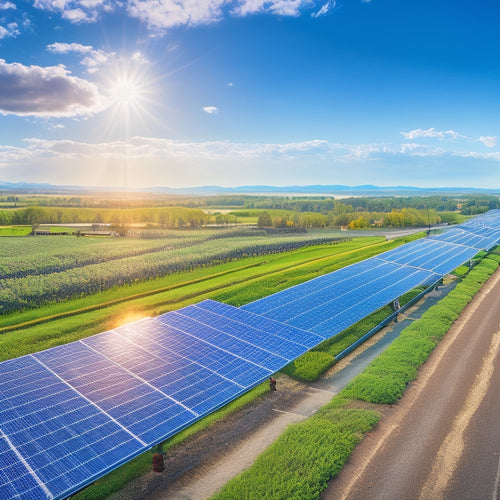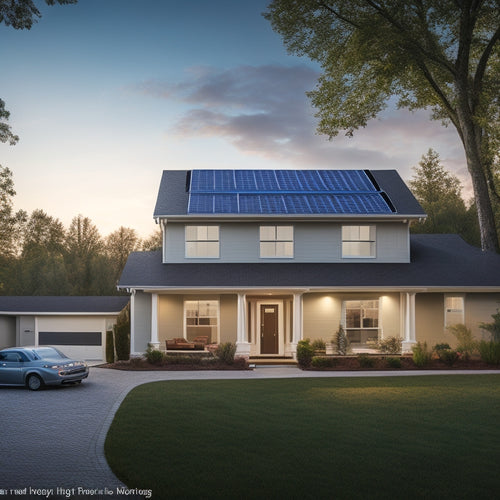
How Do Solar Windows Differ From Traditional Windows
Share
Solar windows differ markedly from traditional windows by incorporating photovoltaic technology that allows them to generate electricity. While traditional windows simply provide light and insulation, solar windows achieve energy conversion efficiencies of 10% to 20%. This integration enables you to reduce energy costs over time, as they produce clean energy and can enhance property value. In addition, their design maintains aesthetic appeal, eliminating bulky external fixtures. With advancements in solar cell technology, such as transparent photovoltaics and various materials, the performance options continue to evolve. If you're interested in understanding their broader implications, there's much more to explore.
At a Glance
- Solar windows incorporate solar cells for energy generation, while traditional windows do not produce electricity.
- Energy conversion efficiency in solar windows ranges from 10% to 20%, significantly enhancing energy utilization compared to conventional windows.
- Solar windows can reduce energy costs and enhance property value over time, offering financial benefits not available with traditional windows.
- They feature innovative designs, such as transparent photovoltaics, blending aesthetics with functionality, unlike the standard designs of traditional windows.
- Solar windows require minimal maintenance, providing a more convenient ownership experience compared to traditional window systems.
Energy-Efficient Design Advantages
When you consider energy-efficient design, solar windows offer enhanced energy generation compared to traditional windows.
By capturing sunlight, they not only produce energy but also help lower your overall energy costs.
This innovative technology allows for improved sustainability by reducing reliance on grid electricity and promoting cleaner energy solutions, contributing to efforts in reducing greenhouse gas emissions.
This dual function makes them an intriguing choice for those aiming to optimize their energy use.
Enhanced Energy Generation
How much energy can solar windows really generate compared to traditional windows? When you consider the advancements in solar technology, solar windows can greatly outperform standard window materials. These innovative windows integrate photovoltaic cells, allowing them to convert sunlight into usable electricity, therefore enhancing energy generation in your space.
| Feature | Solar Windows |
|---|---|
| Energy Conversion Efficiency | Up to 15% |
| Installation Flexibility | Retrofit Existing Windows |
| Aesthetic Options | Various Styles Available |
| Environmental Impact | Reduces Carbon Footprint |
| Maintenance Needs | Minimal |
Unlike traditional windows, which merely allow light to enter, solar windows actively utilize energy, altering your building into a power-generating asset. This capability not only maximizes your energy efficiency but also contributes to energy independence. By incorporating solar technology into your design, you're not just enhancing your living space; you're also participating in a more sustainable future. With the ability to generate power throughout the day, solar windows provide a persuasive alternative that aligns with a more liberated lifestyle, promoting both autonomy and responsibility in energy consumption.
Reduced Energy Costs
With solar windows, you can greatly reduce your energy costs compared to traditional windows. These innovative installations integrate solar panel efficiency directly into your building's design, allowing you to generate electricity while also enjoying natural light.
Unlike conventional windows, solar windows capture sunlight to produce energy, effectively decreasing your reliance on grid power.
Understanding your energy usage patterns is vital for maximizing savings. By analyzing when and how you consume energy, you can align your usage with the peak production times of your solar windows. This collaboration enables you to minimize energy bills and possibly even generate surplus energy, which can be sold back to the grid.
Moreover, the technology behind solar windows has evolved remarkably, yielding higher energy conversion rates. This means you can expect a more considerable reduction in costs over time.
As you invest in these advanced solutions, you're not just lowering expenses; you're also contributing to a sustainable future.
Cost Savings Over Time
When you choose solar windows, you're not just investing in aesthetics; you're also reducing your energy bills over time.
These innovative windows can employ technology similar to solar panel efficiency, allowing for energy capture and conversion that further lowers your consumption.
The initial costs may be higher, but the long-term savings from lower energy consumption can greatly offset that expense.
Additionally, these windows can enhance your property's value, making them a smart financial investment.
Energy Bill Reduction
Switching to solar windows can greatly cut down your energy bills over time. These innovative windows convert sunlight into usable energy, reducing your reliance on traditional power sources. As energy prices fluctuate, having a solar window system can provide you with stability and predictability in your monthly expenses.
While the initial installation costs may be higher than traditional windows, you can offset these through various solar incentives, tax credits, and energy rebates. These financial benefits can considerably reduce your upfront investment, making solar windows an attractive option.
Furthermore, as market demand for sustainable solutions rises, you may find that the long-term savings on energy bills surpass initial expenditures.
When considering aesthetic considerations, solar windows blend functionality with style, enhancing your home's appeal without compromising its look. Maintenance requirements are minimal, ensuring you won't be burdened with frequent upkeep.
Additionally, the environmental impact of switching to solar windows contributes to a greener future, aligning with your desire for freedom from fossil fuels. Ultimately, investing in solar windows not only reduces your energy bills but also positions you as a proactive participant in sustainable living.
Long-Term Investment Benefits
Investing in solar windows represents a forward-thinking choice that can lead to considerable cost savings over time. By integrating these innovative technologies into your home or business, you're not just enhancing aesthetics but also gaining financial benefits.
A lifecycle analysis of solar windows reveals that while the upfront costs may be higher than traditional options, the long-term returns can be substantial. These windows capture solar energy, reducing your reliance on grid electricity and lowering your energy bills. Over time, the cumulative savings can offset initial investments, especially when you consider the lifespan of solar windows, which often exceeds that of regular glass.
Additionally, many regions offer financial incentives for adopting renewable technologies. These incentives can greatly decrease your initial expenditure, making your investment even more appealing. By taking advantage of tax credits, rebates, and grants, you can maximize your savings.
Ultimately, solar windows not only contribute to energy independence but also provide an engaging economic rationale. As you weigh your options, consider how embracing this technology can lead to a more sustainable and financially sound future.
Innovative Solar Cell Integration
When considering innovative solar cell integration, you should investigate the various types of solar cells available, including monocrystalline, polycrystalline, and thin-film options.
Each type offers unique benefits and challenges that affect efficiency and aesthetics, especially when considering factors like battery compatibility for energy storage systems.
Additionally, understanding the integration techniques, such as embedding solar cells within glazing or using transparent photovoltaics, is essential for maximizing energy generation while maintaining the functionality of traditional windows.
Types of Solar Cells
As the demand for sustainable energy solutions grows, innovative solar cell integration has emerged as a vital advancement in building design.
You'll find two primary types of solar cells typically used in this integration: monocrystalline technology and thin film solutions. Each offers unique benefits, catering to different design needs and energy goals.
Monocrystalline technology, known for its high efficiency and longevity, employs single-crystal silicon. This type of solar cell converts sunlight into electricity with impressive performance, making it suitable for building-integrated photovoltaics (BIPV).
If you're looking for maximum energy output, monocrystalline cells might be your best bet.
On the other hand, thin film solutions offer a lighter, more flexible alternative. These cells consist of layers of photovoltaic material that can be applied to various surfaces, including windows.
While they generally have lower efficiency compared to monocrystalline cells, their versatility allows for creative applications in modern design.
Integration Techniques Explained
Integrating solar cells into building designs requires a strategic approach to maximize energy efficiency and aesthetic appeal. You'll find various installation methods that cater to different design styles and energy needs.
One popular technique is the use of transparent solar panels that blend seamlessly with traditional glass. This method not only preserves the visual integrity of the building but also allows natural light to flood in.
Another effective approach involves embedding solar cells within the glazing itself. This innovative method guarantees that the solar technology becomes an integral part of the window structure, eliminating bulky external fixtures. Aesthetic considerations are paramount here; the design must complement the overall structure while promoting sustainability.
You might also investigate building-integrated photovoltaics (BIPV), which allow for solar energy capture without compromising the visual appeal of your property. These systems can replace conventional building materials, offering a dual function as both energy generators and design elements.
Ultimately, the key to successful integration lies in balancing functionality and design, guaranteeing that your building not only generates power but also reflects your vision of modern, sustainable living.
Selecting Based on Energy Output
When selecting windows based on energy output, you'll want to focus on energy conversion efficiency and power generation capacity.
Understanding these metrics, along with the importance of efficient battery selection for reliable energy storage, will help you assess how much energy solar windows can produce compared to traditional options.
This knowledge is essential for maximizing energy savings and making informed decisions for your property.
Energy Conversion Efficiency
Energy conversion efficiency plays an essential role in determining the practicality of solar windows compared to traditional windows. When you assess solar technology, you'll find that the efficiency of energy conversion directly impacts how much energy these windows can produce.
Unlike traditional windows, which offer no energy output, solar windows capture sunlight and convert it into usable electricity, albeit at varying efficiencies. Currently, most solar windows achieve energy conversion efficiencies between 10% and 20%. This means that they convert only a fraction of the solar energy they receive into electricity.
As a consumer, you'll want to evaluate this efficiency when selecting solar windows, especially if you're aiming for significant energy savings. Looking into future innovations, advancements in materials and design may enhance these efficiencies, making solar windows a more viable option for energy generation in residential and commercial spaces.
Power Generation Capacity
Understanding the power generation capacity of solar windows is key to making informed decisions about their installation. This capacity largely depends on the solar technology integrated within the window materials. Solar windows convert sunlight into usable electricity, allowing you to utilize energy directly from your building's façade.
When evaluating solar windows, consider their wattage output per square foot. Typically, these windows produce less energy than traditional solar panels; however, advancements in solar technology are closing that gap. Some innovative designs now achieve outputs that make them competitive with standard photovoltaic systems, especially in urban areas where space is a constraint.
Moreover, factors such as orientation, shading, and local climate conditions greatly affect energy generation. It's crucial to analyze how these elements interact with the specific window materials used in your solar windows. Opting for high-performance glass or transparent photovoltaic coatings can enhance energy output.
Ultimately, determining the right solar window involves balancing aesthetics, performance, and energy needs. By understanding these aspects, you can select solar windows that not only complement your space but also enable you to generate sustainable energy right where you live.
Higher Energy Conversion Efficiency
When you consider solar windows, enhanced light absorption plays an essential role in achieving higher energy conversion efficiency.
These windows are designed to utilize more sunlight, converting it into usable energy more effectively than traditional options.
Enhanced Light Absorption
While traditional windows primarily serve to provide natural light and insulation, solar windows enhance light absorption to considerably improve energy conversion efficiency. By utilizing advanced materials, these windows capture a wider light range, allowing you to utilize solar energy more effectively. This is particularly advantageous with ideal window orientation, where the angle can maximize sunlight exposure.
Here's a comparative analysis of light absorption features:
| Feature | Traditional Windows | Solar Windows | Benefits |
|---|---|---|---|
| Light Range Utilization | Limited | Broad | Captures more solar energy |
| Window Orientation Efficiency | Moderate | High | Maximizes energy capture |
| Energy Conversion Rate | Low | High | Higher efficiency translates to savings |
| Material Composition | Glass | Photovoltaic Coatings | Enhances durability and performance |
Adopting solar windows means you're not just passively relying on sunlight; you're actively converting it into usable energy. This shift not only enables you to reduce your energy bills but also contributes to a sustainable future. Reflect on the potential of solar windows as a way to reclaim your energy independence while embracing innovative technology.
Frequently Asked Questions
What Materials Are Used in Solar Windows Compared to Traditional Windows?
You'll find solar windows employ advanced materials like transparent conducting oxides and organic photovoltaics, enhancing energy efficiency through solar cell integration. In contrast, traditional windows mainly use glass and metal frames, lacking energy-generating capabilities.
Can Solar Windows Be Installed in Any Building Type?
Imagine changing any building into a sunlit powerhouse! Solar windows can often be installed, but you'll need to evaluate installation feasibility and building regulations to guarantee a seamless integration that enables your energy independence.
How Do Solar Windows Affect Indoor Lighting?
Solar windows enhance indoor lighting through effective light diffusion, allowing natural light to permeate spaces while optimizing energy efficiency. You'll benefit from reduced energy costs and improved ambiance, creating a more comfortable environment for your freedom-loving lifestyle.
Are There Maintenance Differences Between Solar and Traditional Windows?
When considering maintenance differences, you'll find solar windows require specific cleaning methods to avoid damage. Their lifespan comparison with traditional windows shows they may need less frequent maintenance, ultimately enhancing your freedom from upkeep hassles.
Do Solar Windows Come With Warranties or Guarantees?
Around 90% of solar windows offer warranty coverage, often spanning 25 years. These warranties typically include performance guarantees, ensuring you maximize your investment while enjoying the freedom of clean energy without constant concerns about functionality.
Explore More
In a world where energy efficiency reigns supreme, solar windows present a modern twist on traditional designs, much like Prometheus bringing fire to humanity. By integrating innovative solar cells, these windows not only enhance aesthetics but also greatly increase energy output. As you weigh the long-term cost savings and higher energy conversion efficiency, consider how adopting solar windows can change your environment into a sustainable haven, echoing the timeless quest for harmony between nature and technology.
Related Posts
-

Applications of Photovoltaic Systems
Photovoltaic systems are versatile, converting sunlight into electricity for various applications. You can use them i...
-

Cost of Solar With Battery Backup
You're investing in a solar panel system with battery backup to guarantee reliable power during outages. The cost of ...
-

Key Features of a DC to AC Converter
A DC to AC converter features high efficiency and conversion rates, which reduce energy costs and improve performance...


